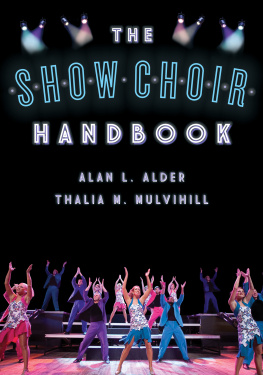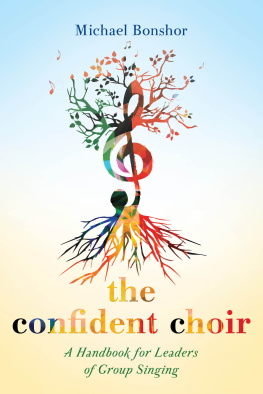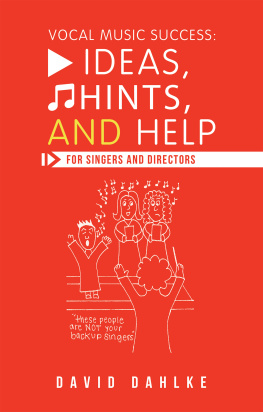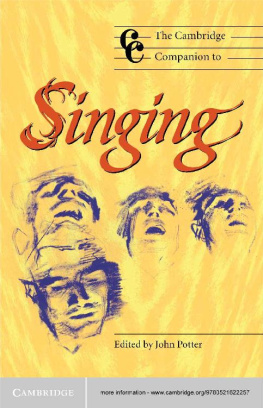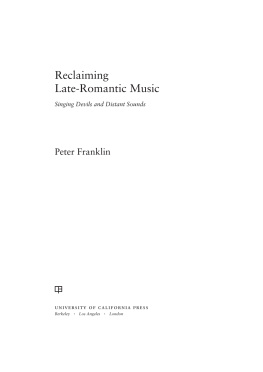David Friddle - Choral Treatises and Singing Societies in the Romantic Age
Here you can read online David Friddle - Choral Treatises and Singing Societies in the Romantic Age full text of the book (entire story) in english for free. Download pdf and epub, get meaning, cover and reviews about this ebook. year: 2022, publisher: Lexington Books, genre: Romance novel. Description of the work, (preface) as well as reviews are available. Best literature library LitArk.com created for fans of good reading and offers a wide selection of genres:
Romance novel
Science fiction
Adventure
Detective
Science
History
Home and family
Prose
Art
Politics
Computer
Non-fiction
Religion
Business
Children
Humor
Choose a favorite category and find really read worthwhile books. Enjoy immersion in the world of imagination, feel the emotions of the characters or learn something new for yourself, make an fascinating discovery.

- Book:Choral Treatises and Singing Societies in the Romantic Age
- Author:
- Publisher:Lexington Books
- Genre:
- Year:2022
- Rating:4 / 5
- Favourites:Add to favourites
- Your mark:
- 80
- 1
- 2
- 3
- 4
- 5
Choral Treatises and Singing Societies in the Romantic Age: summary, description and annotation
We offer to read an annotation, description, summary or preface (depends on what the author of the book "Choral Treatises and Singing Societies in the Romantic Age" wrote himself). If you haven't found the necessary information about the book — write in the comments, we will try to find it.
David Friddle: author's other books
Who wrote Choral Treatises and Singing Societies in the Romantic Age? Find out the surname, the name of the author of the book and a list of all author's works by series.
Choral Treatises and Singing Societies in the Romantic Age — read online for free the complete book (whole text) full work
Below is the text of the book, divided by pages. System saving the place of the last page read, allows you to conveniently read the book "Choral Treatises and Singing Societies in the Romantic Age" online for free, without having to search again every time where you left off. Put a bookmark, and you can go to the page where you finished reading at any time.
Font size:
Interval:
Bookmark:

Choral Treatises and Singing Societies in the Romantic Age
Published by Lexington Books
An imprint of The Rowman & Littlefield Publishing Group, Inc.
4501 Forbes Boulevard, Suite 200, Lanham, Maryland 20706
www.rowman.com
86-90 Paul Street, London EC2A 4NE
Copyright 2022 by The Rowman & Littlefield Publishing Group, Inc.
All rights reserved. No part of this book may be reproduced in any form or by any electronic or mechanical means, including information storage and retrieval systems, without written permission from the publisher, except by a reviewer who may quote passages in a review.
British Library Cataloguing in Publication Information Available
Library of Congress Cataloging-in-Publication Data
Names: Friddle, David, author. | Quist, Amanda, writer of foreword.
Title: Choral treatises and singing societies in the romantic age / David Friddle; [foreword by Amanda Quist].
Description: Lanham : Lexington Books, 2022. | Includes bibliographical references and index.
Identifiers: LCCN 2022019711 (print) | LCCN 2022019712 (ebook) | ISBN 9781666911114 (cloth) | ISBN 9781666911121 (ebook)
Subjects: LCSH: Choral singing--Instruction and study--History--19th century. | Choral societies--History--19th century.
Classification: LCC ML1505 .F73 2022 (print) | LCC ML1505 (ebook) | DDC 782.509/034--dc23/eng/20220511
LC record available at https://lccn.loc.gov/2022019711
LC ebook record available at https://lccn.loc.gov/2022019712
 The paper used in this publication meets the minimum requirements of American National Standard for Information SciencesPermanence of Paper for Printed Library Materials, ANSI/NISO Z39.48-1992.
The paper used in this publication meets the minimum requirements of American National Standard for Information SciencesPermanence of Paper for Printed Library Materials, ANSI/NISO Z39.48-1992.
DEDICATED TO PROFESSORS
TIMOTHY NEWTON JO-MICHAEL SCHEIBE NICK STRIMPLE
whose considerableand ongoingcontributions helped make this volume possible, and whose expert navigation kept my ship on its course: please accept my heartfelt gratitude.
PLUS, A THOUSAND THANKS TO
Stuart, Ryan, Jon, Frank, & Bill
for reading, commenting, rereadingand encouraging me to keep goingespecially when the going got tough
T here are several folks who helped translate the many sources contained herein. Because they are of the nineteenth century and contain specialized music terms, the sources required someone who could not only make sense of antiquated language; these individuals also needed musical knowledge. Anthony Krupp, PhD, as he did with Christus, ensured that my translations of the convoluted German textsprinted in Fraktur font, no lesswere accurate and intelligible; Professor Mari Siiroinen, of the Helsinki Institute for Social Sciences and Humanities, translated the Finnish texts without even being asked; Monica Faust Figueroa, PhD, UGrow Fellow, ASPIRE at the University of Miami helped me with Spanish and Portuguese; Lucia Marchi, Ph. D., of the Department of Modern Languages/School of MusicDePaul University, translated several pages of antiquated Italian into comprehensible English; Maria Lyon graciously verified my Swedish translations; Costijn Sommeling and the staff of De Juiste Vertaler translated the Dutch, Danish, and Norwegian.
Jo-Michael Scheibe, USC Thornton School of Musics Professor of Choral and Sacred Music, read and critiqued this book, much to myand every readersbenefit; USC Professor and author Nick Strimple offered me his sagacious advice about how to make this tome more useful to our profession. My dear, longtime friend Dr. Ryan Holder, Professor at Northern Arizona University, agreed to the thanklessand laborioustask of making sure all the tables, figures, and musical examples were sequential, without repetition or omission.
Dr. Stuart Dunkel, my Juilliard classmate and longstanding and benevolent friend, made possible the recordings that accompany this book. Thank you, Stuart.
Dr. Timothy Newton, Professor of Music at SUNY Oneonta, helped tremendously as this book took shape. Originally, this volume was combined with its companion book, Sing Romantic Music Romantically, to form an unworkably large book; it was Tim who first suggested that the material that ultimately became this volume was a separate book and should be a stand-alone work. His editorial and publishing expertise to this project undoubtedly makes it a more useful work that otherwise would have been the case. And to Courtney Morales, Emma Ebert, and Linda Kessler of Lexington Books/Rowman & Littlefield, I send my sincere appreciation and gratitude for helping see this extremely complicated project to fruition.

My relationship with Dr. Amanda Quist, director of choral activities for the Frost School of Music at the University of Miami, was initially limited to producing graphic materials for the annual choral studies holiday dinner fundraising event, which Ive gladly done for three years. Quite unexpectedly, our professional relationship has developed into such that she graciously agreed to write the Foreword for this volumeno small feat given its page count and complexity. Amanda also connected me with New York Citybased conductor and choral scholar Dr. Ryan James Brandau, who read this volume carefully and made many helpful suggestions, all of which I gladly incorporate. I am especially indebted to her, both professionally and personally, for these significant contributions, which has made this book better on any number of fronts.
I am also grateful to the Minnesota State Arts Board: This activity is made possible by the voters of Minnesota through grants from MSAB thanks to a legislative appropriation from the arts & cultural heritage fund.
And, finally, to the dozens of person who kindly replied to my emails, provided me with information and helped me locate sources and images, I borrow from the German and Italian languages the phrase that best shows my gratitude: Tausend dank and Mille grazie. There are 123,017 words in this book. Even though I have been as careful, and thorough as anyone could possibly be, the chance that there are zero misspelled, mistranslated, or incorrect words is zero; if I omitted a citation, believe me when I say it was an oversightit is not my habit to steal intellectual property and many hours of research, writing, editing, correcting and so forth from colleagues. I hope readers will give me the benefit of the doubt and trust that the many months and significant personal financial expenses I have invested in this project motivate me to create the highest-quality book I can create.
T here will be instances herein where I will switch to a sans serif font when I express my personal beliefs, or want to slip into a voice that is a bit more informal. Whenever I quote an English source verbatim, I enclose it between quotation marks. English sources that I paraphrase are credited with a footnote at the end of the quote. Since I believe that any translation is a paraphrase, I credit every source with quotation marks at the end of the quote. Each footnote contains the text of the quote in its original languageGerman, Spanish, Catalan, French, Italian, Portuguese, Swedish, Finnish, Danish, or Norwegian.
All the Ftis exercises have been imploded into a grand staff. Readers can download PDFs of them all at http://www.audioexamples.net/Fetis-Exercises-Complete.pdf . Likewise, there are audio and video recordings of selected examples available online. Recordings are identified herein with this icon: 
Font size:
Interval:
Bookmark:
Similar books «Choral Treatises and Singing Societies in the Romantic Age»
Look at similar books to Choral Treatises and Singing Societies in the Romantic Age. We have selected literature similar in name and meaning in the hope of providing readers with more options to find new, interesting, not yet read works.
Discussion, reviews of the book Choral Treatises and Singing Societies in the Romantic Age and just readers' own opinions. Leave your comments, write what you think about the work, its meaning or the main characters. Specify what exactly you liked and what you didn't like, and why you think so.

